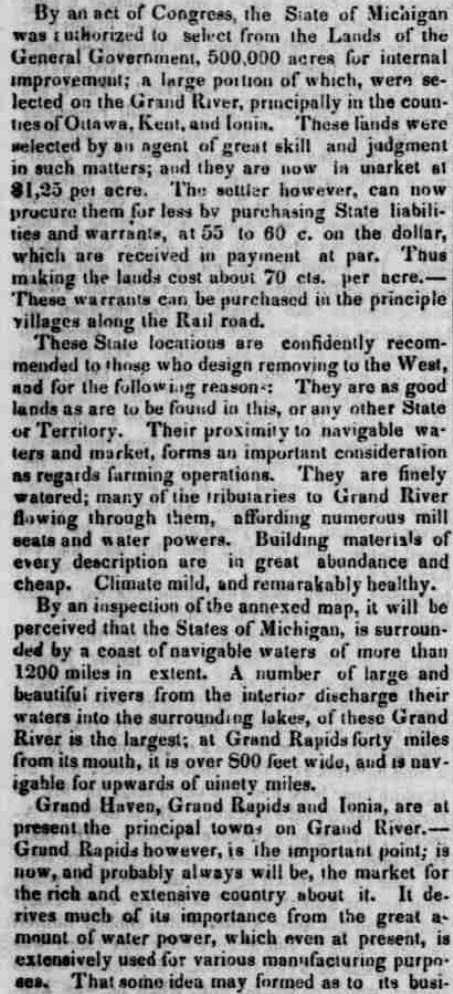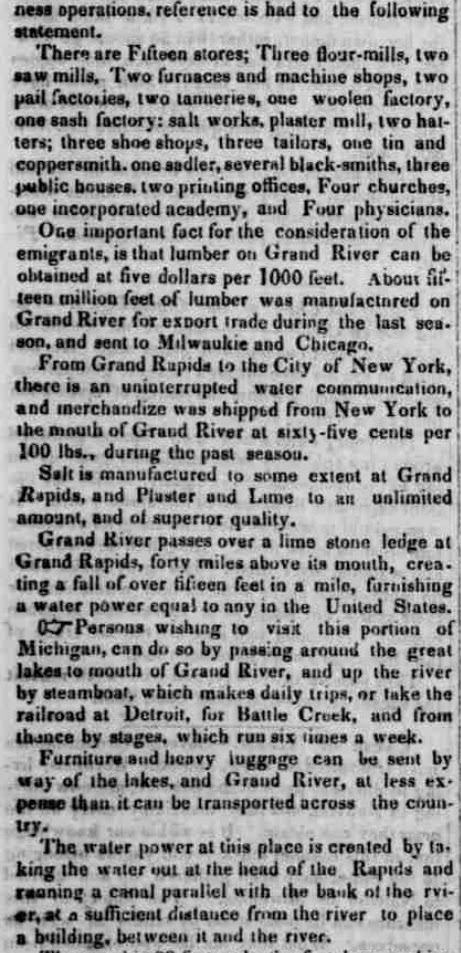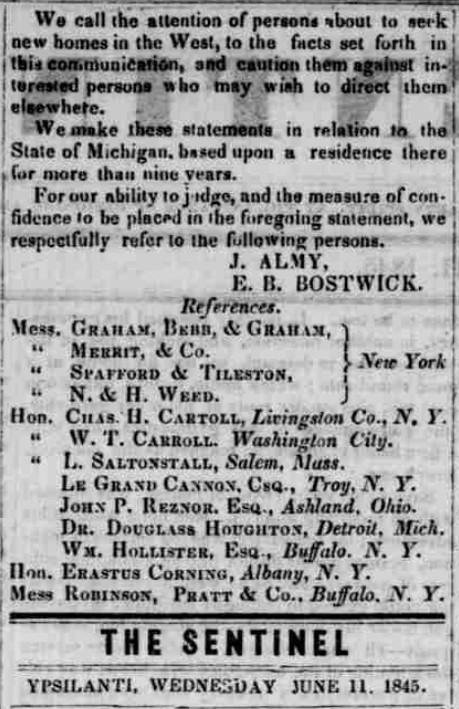| Perkins, S. F., Shoe Store and Tanner, Monroe St. |
| PERKINS, WOODARD & CO., Shoe Store and Tanners, Monroe St. So reads the entry for Samuel Field Perkins in the 1856 Grand Rapids Business Directory. Baxter has this to say on page 104 of his "History of the City of Grand Rapids, Michigan".
Samuel was carrying on the family trade, as learned at his father's side in Woodstock, Vermont.
|
The Gaius Perkins home in South Woodstock, Vermont, built in 1831, courtesy Google Maps.
On page 494 of Baxter, we find the following account of Samuel's trade. Also mentioned is Charles Taylor, the subject of a previous post.
Here is the site of the Perkins and Woodward Tannery on Mill Street to the left of the East Side Canal, from the Henry Hart map of 1853.
The site where Samuel and Mary built their house is shown above on the corner of Pearl Street and Greenwich Street, Lot #8. Subjects of previous posts who also lived on the same block are William Haldane, Dr Charles Shepard, and Dr Lemuel Putnam.
Looking down Pearl Street East, either from the tower in William Haldane's back yard or the Ledyard Building, after 1879. The house in the middle with front facing Ionia is Byron Ball's. Next coming forward is Samuel Perkins'. Across the street is the new Post Office building.
You can see this house from the other direction at the top of this page, right behind the right steeple of St Mark's Church.
Looking West down Pearl Street about 1910 at the cross of Ionia. On the right is the Post Office fence. The house on the corner was built about 1842 by Samuel F and Mary D Perkins, and lived in continuously by the family until demolition after 1913. The space occupied by the Michigan Trust Company once held the homes of George H Foster, Charles D Preston, George Smith, and William Haldane. On the next corner, Pearl and Ottawa, is the Ledyard Building with its beautiful roofline.
The Grand Rapids Herald, Wednesday Morning, December 24, 1913.
Dies In Home She Occupied 70 Years
Mrs. Mary Perkins, Pioneer Resident of City, Was near Centenarian.
Sentiment Was Strong
Business Interests Encroached Upon Modest Homestead But Could Not Prevail Against Life-Long Wish.
Caring more for her modest home than a palatial mansion and watching year after year the steady and relentless encroachment of business interests, the one great wish of Mrs. Mary D. Perkins, 94 years old, had its fulfillment when she died yesterday within the walls of the Perkins homestead at Ionia avenue and Pearl street.Mrs. Perkins was a pioneer resident and the widow of Samuel F. Perkins one of the city's earliest and well known business men. She was a native of Ithaca, N.Y. and came to Grand Rapids from Ohio in 1840. Samuel F. Perkins became a resident of Kent county in 1837 and was one of the first members of the "old Settler's Society of Kent County." Shortly after her marriage, Mrs. Perkins took up her residence in the house in which she died.
Contrast Afforded.
For 70 years Mrs. Perkins resided in the little one story and a half frame structure. The building never failed to attract the attention of visitors to Grand Rapids because of the contrast afforded and a tender story of sentiment was usually unsuspected by the passing pedestrian. Towering 10 stories high to the west of the Perkins homestead is the Michigan Trust building. Directly across Pearl street is the Y.M.C.A. which has already outgrown its quarters and will have a larger and more handsome home. Across Ionia and on the corner Mrs. Perkins noted the building of a handsome new federal building. Within a half block two of the largest furniture exposition buildings were erected.One of the these, the Furniture Exposition building, abuts upon the Perkins lot, which extends along Ionia avenue for a distance of about 140 feet. Between the Perkins lot and the Trust building another vacant lot is located of about the same size.
Lot Valued at $80,000.
Within the rapid growth of the city, enterprising real estate men and financiers have looked upon the Perkins lot as being one of the most valuable in the city, and repeated efforts have been made to acquire the property. When hotel building talk was at its height a short time ago, Dudley E Waters procured an option on the corner, the price being fixed at $80,000. With increased building activity in the business section the value of the real estate grew year after year and as an investment, the modest little home did not yield new revenue, but it did afford solace to the pioneer woman who could not bear to leave the spot so dear to her heart. She has been in excellent health, considering her advanced years, until a few years ago, when she became ill.Mrs. Perkins is survived by a son, Gaius W Perkins, president of the Perkins Lumber company; two grandsons, Charles F and Gaius W Perkins Jr., and two first great-grandchildren, Voigt and Pauline Perkins.
Funeral services will be held at the home of her son, 241 Fountain street this afternoon at 2:45 o'clock. Burial will be in the Fulton street cemetery.
The unlovely view, today.
Samuel Field Perkins and Mary Desire McIntyre married 4 September 1842, according to Albert Baxter, p 623. Samuel died 14 February 1866 and is buried in Fulton Street Cemetery, as was Mary.
Son, Frederick Barker Perkins, a grocer, born 13 June 1843, died a suicide 2 April 1890, married with one son. The family lived in Albany, New York before moving back to Michigan.
Son, Charles Dunham Perkins died at the age of two years and is buried in Fulton Street Cemetery.
Son, Gaius William Perkins started the Grand Rapids School Furniture Company in 1887 and moved it to the West Side, Broadway, between 9th and 10th. He was an active and influential member of the Grand Rapids Board of Trade, a director of several banks, an officer of the Citizen's Telephone Company in 1906, and a board member of the Grand Rapids and Lake Michigan Transportation Company.
He married Emma Louise Pike, a daughter of Abram W Pike, and had Charles Francis, 11 June 1870, who married Amanda N Voigt; Frederick Louis, 1 August 1872, died 14 March 1875; and Gaius William Jr, born 30 January 1879, and married Jessie Eunice Watkins 3 March 1913. Gaius William Sr died 23 April 1934.
Here is the house Gaius Perkins built for himself, courtesy of Grand Rapids As It Is, 1888.. A lot different than the one he grew up in. Built in 1881, in 1883 it was listed as 183 Fountain, later changed to 181 Fountain, then 241 Fountain in 1912.
In 1891 the house had a beautiful wraparound porch. Windows have been added and dormers enlarged. This from Baxter's.
In 1917 it was extensively remodeled, and today the front door is on Lafayette and it is listed as 111 Lafayette.
Picture courtesy of Heritage Hill.org. This link gives history of the house to 1971.
Here is a little more on Samuel's father Gaius Perkins, from The Family of John Perkins of Ipswich, Mass:Complete in Three Parts (Google eBook), George Augustus Perkins, 1884.
Pp95-6
339
Gaius (Wm. 246,
Abraham 152, Abraham 64, Isaac 12, John 2,
John 1) was born in Lyme, Conn Sept 9, 1778.
He
removed to Hartland, Vt., and afterwards to South Woodstock, Vt., in 1801. There he married Eunice Field, June 26,
1804. She was born Feb. 12, 1785, and died June 25, 1858. He carried on an
extensive business of tanning and shoemaking in South Woodstock for many years
and died there March 3, 1870.
He was an
ardent supporter of institutions of learning and contributed largely towards
the establishment and support of an academy in South Woodstock. We quote the following in relation to him
from Prof W. R. Shipman.
“Major
Gaius Perkins died in South Woodstock, March 3, 1870, aged ninety-one years and
six months. His long life was not more remarkable for the number of its days
than for the wonderful preservation, to its very close, of the faculties and
spirit of youth. He was not, indeed, exempt from the weariness of age, but not
one of his senses was materially impaired; his judgment remained adequate to
the transaction of business, while his heart was as young as ever; and his
interest in passing events, whether of the neighborhood or the nation was
undiminished.
Naturally
social, he was to the last a genial companion for all, and his beautiful old
age was a perpetual joy to the home in which children's children rose up to
call him blessed. His favor was extended to all good enterprises, and be always
heeded the injunction to ‘follow after the things that make for peace.’
A
life-long and active Universalist, his venerable form was, until very recently,
familiar in the gatherings of the denomination far and near. He made the first
and largest subscription in Vermont for the Green Mountain Central Institute,
(Now the Green Mountain Perkins Academy), and gave more than any others to sustain
our school at South Woodstock. It was hardly too much to say that, as his last
days were his best so like the evening twilight were his lingering years.
Honored and loved by a multitude of friends, his memory will long be cherished
in their hearts, while he, departing from the earth at peace with man and God,
and now, united with the great company of the redeemed, shall dwell forever in
the mansions of the blest.”
Children
of Gaius and Eunice Field Perkins were:
510 Samuel Fields, b May 12,1805;
d Feb 14,1866.
511
Adeline, b Aug 18,1807;
unm’d; d Feb 19,1830.
512
Marcia, b March 1,1809.
513
Frederick, b Oct 18,1810
d March 23,1868.
514
Charles Dunham, b
March 23,1813.
515
Edward, b April 9,1815;
unm’d; d in 1882.
P 132
510
Samuel Fields,
(Gaius, 329 William, 246
Abraham, 152 Abraham, 64 Isaac, 12 John,
2, John, 1) was
born in South Woodstock, Vt., on Sunday, May 12, 1805. He married Sept. 4, 1842,
Mary Desire McIntyre who was born in Hector, Tompkins County, NY, Feb. 25,
1819. She was the daughter of Thomas and Desire (Barker) McIntyre. He
was from Deerfield, Mass., and she was from Connecticut.
Soon
after he became of age he removed from South Woodstock, Vt. to Plattsburg, NY,
where he resided one or two years; thence to Lockport, NY, and from there to
Detroit, Mich., about the year 1832, where he remained until 1836. He then
removed to Grand Rapids, Mich., and settled there permanently. Here he
established himself in the boot and shoe business and built a tannery, which he
conducted during the remainder of his life. He died Feb.14, 1866.
Children
of Samuel F and Mary (McIntyre) Perkins were:
697
Frederick Barker, b
June 13, 1848.
698
Charles Dunham, b
Nov 13, 1845; d May 13, 1847.
699
Gaius William, b
July 16, 1847.
P 157-8
697
Frederick Barker (Samuel
F, 510 Gaius, 329 William, 246 Abraham, 152
Abraham, 64 Isaac, 12 John, 2 John,1)
was born in Grand Rapids, Mich., June 13, 1843. He married Agnes J Wishart,
Nov.1867. He resided in Grand Rapids until 1874, when he removed to Albany, NY,
where he now lives. He is engaged in the grocery trade.
Child of Frederick
and Agnes (Wishart) Perkins was:
817
Edward Wllllam b
Jan 22, 1872.
699
Gaius William (Samuel
F, 510 Gaius, 329 William, 246 Abraham, 152
Abraham, 64 Isaac, 12 John, 2 John,1)
was born in Grand Rapids, Mich., July 16, 1847. He married Sept 9, 1869, Emma
Louisa Pike, of Grand Rapids. He is engaged in the hide, wool and fur trade in
Grand Rapids.
Children
of Gaius and Louisa (Pike) Perkins were:
818
Charles Francis, b
July 11, 1870.
819
Frederick Louis, b
Aug 1, 1872; d March 14, 1875.
820
Gaius William, b
Dec 30, 1878.The Green Mountain Perkins Academy in South Woodstock is still there, now a museum.
Frederick Barker Perkins returned to Grand Rapids after 1880 and died a suicide at the age of 47. He had been a tanner and a grocer.
Gaius William Perkins started the Grand Rapids School Furniture Company which became American Seating Company.
From "The Men Behind the Guns in the Making of Greater Grand Rapids", p 174-5.
OK, so now I want to know what a "Hoo Hoo" is. (see above) Here is a description and the ritual of membership, which includes the kissing of a cat statue's butt. It is not a very serious fraternal organization. Wikipedia also has this.














































